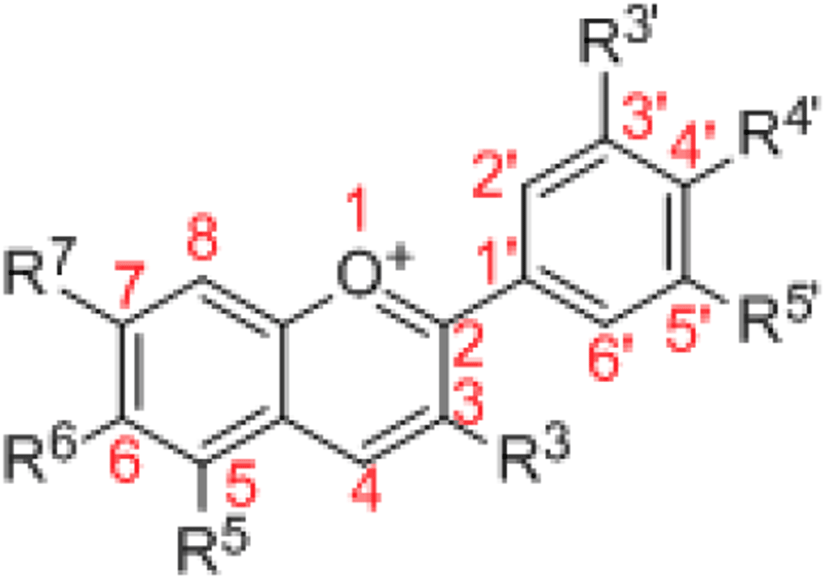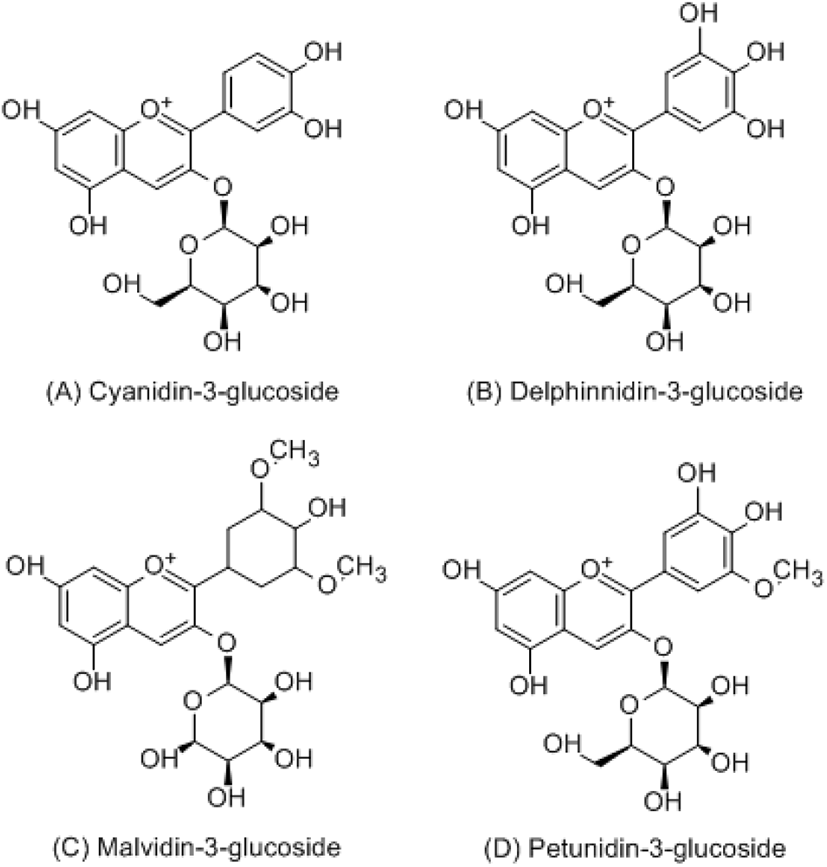Ⅰ. 서 론
현대의 소비자들은 합성색소에 대한 인식의 변화와 규제의 강화에 많은 관심을 가지고 있으며 천연색소 개발 또한 활발히 진행되고 있다. 천연색소 중 자연계에서 가장 쉽게 찾을 수 있는 색소로 안토시아닌이 있으며, 430여 종의 종류가 알려져 있고 이들은 적색, 청색을 나타낸다(1). 안토시아닌은 플라보노이드 중 하나로 간주되지만, 기본 플라보노이드 c-링 부분의 산소원자에 양전하가 있는 형태이며 페놀 그룹에 속하는 착색된 수용성 안료이다(1, 2). 빨간색과 파란색을 담당하는 대부분의 안토시아닌은 꽃과 많은 식물의 열매에 들어있다. 안토시아닌의 안정성의 경우 pH, 빛, 온도에 영향을 받으며 산성의 조건에서 적색, 알칼리성 조건에서 청색으로 존재한다. 이러한 안토시아닌들은 다양한 색소로 식품, 화장품 등의 분야에서의 가치를 높일 수 있게 해주고, 색소 착색, 첨가에 대한 함성타르계로부터의 문제점들을 해결할 수 있는 방안이 된다. 안토시아닌은 항 당뇨병제, 항암제, 항염증제, 항균제 및 항비만 작용뿐만 아니라, 심혈관 질환의 예방의 효과를 가지고 있다. 따라서 식물에서 추출한 안토시아닌은 잠재적인 제약성분을 함유하고 있음을 확인할 수 있다(Figure 1)(3).
Ⅱ. 대표적인 안토시아닌의 종류와 효능(Table 1; Figure 2)
플라보노이드 부류의 분자에 속한다. 식물에 분포된 가장 흔한 안토시아닌 중의 하나로 식물에 가장 많이 함유되어 있는 성분이기도 하다. 적색 안료로 붉은 고구마, 자주색 옥수수와 같은 붉은 색 채소의 주요 안료로 작용한다(2). 화학요법 및 화학 예방의 활성을 가지며, TPA로부터의 악성 및 악성피부의 종양수를 감소시키는 화장품 원료로의 사용이 가능하다. 또한, 뇌 기능 향상, 노화와 관련된 산화 스트레스, 항산화작용에 매우 효과적인 성분이다(4).
| Experiment on efficacy | |
|---|---|
| Anticancer effect | Alleviated glomerular angiogenesis of diabetic kidneys by attenuating the induction of VEGF and HIF-1α in studied mice (9). |
| Visual health | Improved visual function in patients with normal tension glaucoma (10). |
| Anti-obesity | Improved weight gain and lipid profile on obese rats (11). |
| Antimicrobial | Possessed antimicrobial activity through damaging and destroying the cell wall, membrane and intercellular matrix (12). |
1차 식물성 안료로 Cyanidin-3-glucoside와 같이 항산화 작용이 높은 안토시아닌 성분으로 메탄올에 가장 잘 녹는다. 식물에서 청색, 적색의 형태로 나타나며, 꽃의 푸른 색조는 delphinidin-3-glucoside에 의한 것이다. Delphinidin-3-glucoside를 이용하여 꽃의 시각적인 효과를 더해 감각적으로 표현할 수 있다(5). Delphinidin-3-glucoside는 췌장의 β-세포에서 인슐린 분비를 효과적으로 돕는 것으로 보고되었으며, Staphylococcus aureus 감염을 치료하는 항균효과로 잘 알려져 있다(6). 또한, 면역 억제활성 성분으로도 알려져 있다(7).
다른 안토시아닌 성분과는 다른 O-메틸화 안토시아닌이다. 쌍극자 모멘트가 메탄올 및 에탄올보다 높기에 메탄올 및 에탄올에 비해 물에 잘 녹는 성질이 있다. 진한 보라색의 형태를 나타내는 성질을 가지며, Summer wave Blue 성분이 풍부하기에 적포도주에서 주요 색소로 이용이 된다. Malvidin-3-glucoside는 다른 안토시아닌에 비해 상대적으로 가장 높은 항산화 활성을 가졌으며, 식물의 꽃잎과 블루베리에서 찾을 수 있다(4, 5).
Petunidin-3-glucoside은 메틸화된 안토시아닌으로 비메틸화 구조보다 덜 적색화되는 효과 때문에 일반적으로 적색을 띠는 열매에서 발견되지 않는다. 때문에 포도와 같은 청색의 색을 띠는 과일에서 형성된다. 물에 잘 녹으며 진한 적색 또는 자주색의 색을 띤다. Petunidin-3-glucoside는 항산화 및 항균 등의 이로운 점들이 잘 알려지지 않아 인기가 적은 안토시아닌 중 하나이다(8).
Ⅲ. 안토시아닌의 이용 분야
식품이나 화장품 등의 색은 식품의 품질과 선호도를 증가시키는 아주 중요한 요소이다. 일반적으로 식품 제조 공정에는 식용색소를 첨가하는데 소비자들의 식품이나 화장품에 대한 인식이 건강, 위생 측면을 중요시하기에 독성으로부터의 안정성의 우려가 높아졌다(13). 때문에 천연색소의 안토시아닌은 현재 많은 분야에서 이용되어지고 있다. 식품 분야 등에서의 시각적인 가치를 높일 수 있으며 독성이 낮거나 전혀 없는 천연 착색제로 합성 착색제에 비해 고용량으로 안전하게 섭취할 수도 있다(2). 의학분야에서는 항암작용, 항생제, DNA 손상 억제, 면역 증강, 성인병 등의 효과가 보고되어지고 있다. 이를 응용한 기술로는 동물의 사료에 항생제를 대체하는 성분으로 사용되어질 수 있다. 또한, 안토시아닌이 다량 축적된 ‘보안찰보리’가 개발되어졌고, 이를 개선하여 높은 함량의 안토시아닌과 기능성 사료로서의 이용성을 개발할 수 있다(14, 15).
Ⅳ. 결 론
국내시장의 모든 식품, 화장품 등의 색소 첨가, 착색제 등으로 합성 타르계 성분들이 이용되어지고 있다. 이는 현재 많이 쓰여지고 있는 기술이기는 하나, 인공적으로 만들어 내기에 인체 내에서 혈액, 간, 콩팥장애, 발암성의 위험을 가지고 있으며 알레르기가 유발될 수 있을 뿐만 아니라 많은 경제적으로도 많은 비용이 발생한다. 결국, 이러한 문제점들을 해결하기 위해서는 안토시아닌과 같은 천연색소성분들을 이용하여 응용기술을 개발해야 한다. 현재 안토시아닌의 성분이 가지고 있는 문제점인 안정성에 관한 문제들을 보완하고, 순도를 높일 수 있는 추출법을 개발하여야 한다. 그러면 착색제, 색소 첨가를 이용하는 분야에서의 시각적인 효과에 의한 가치를 높이고, 인체에 보다 더 건강한 첨가 재료를 얻을 수 있을 것이다.








